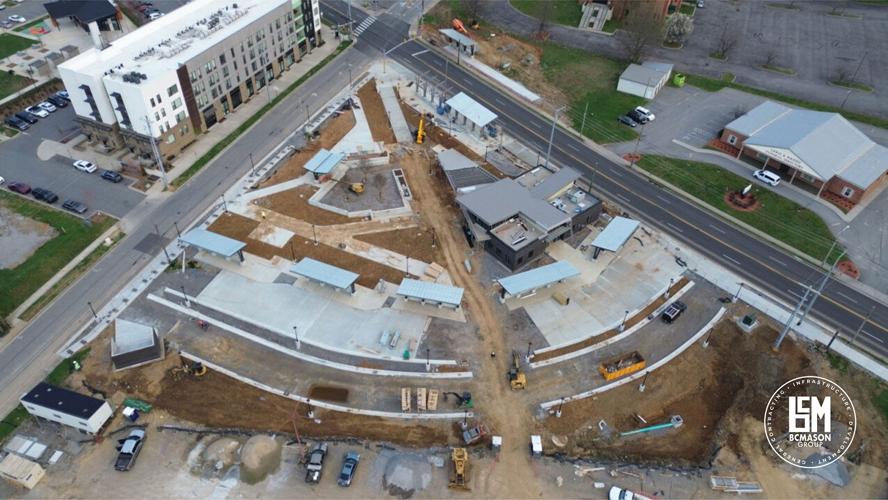Street View is a monthly column taking a close look at development-related issues affecting different neighborhoods throughout the city.
Nashville has big plans for transit: A referendum is planned for the November ballot, new multimodal plans are set to be unveiled this week, and millions of dollars in federal funding is slated for improvements on busy corridors.
Among these large-scale efforts is a transit center in an area with the highest rate of public transit use in the city: North Nashville.
Scheduled to finish construction this spring, the Dr. Ernest “Rip” Patton North Nashville Transit Center, named for a Nashville civil rights hero, is located at 26th Avenue North and Clarksville Highway. Although the building is not yet open to the public, there are already routes running to its location as part of WeGo’s March service improvements. These routes include the 22 Bordeaux, the 42 St. Cecilia/Cumberland, the 75 Midtown, the 77 Thompson/Wedgewood, and an extended 9 MetroCenter line. There’s also a crosstown bus route from Trinity Lane.
The center has been a nearly six-year project for WeGo, Nashville’s transit authority. WeGo initially considered the site after the 2016 nMotion strategic plan included a proposal for transit centers outside of downtown — designed to reduce people’s need to transfer through WeGo’s downtown hub for bus routes across the city.
WeGo began discussions with the landowner at 26th Avenue North and Clarksville Highway in 2018 and formed a North Nashville Transit Center Advisory Committee in 2020, including attendees from previous community meetings, neighbors, stakeholders and local leaders. Groundbreaking happened in November 2022.
WeGo media representative Eric Melcher says the transit center is currently “80 percent finished.” Bus lines run to the street outside the center, but Melcher says the buses will park in dedicated bays when crews complete the center’s construction.
The new center is part of a citywide push to make multimodal transportation safer and more accessible. Mayor Freddie O’Connell’s office unveiled draft concepts for the “Choose How You Move” initiative in March, showing bus rapid transit options, improved sidewalks and traffic signals, and new transit routes. The BRT routes are designed to be a flexible alternative to light rail and will run on Dickerson Pike, Gallatin Pike, Murfreesboro Pike and Nolensville Pike.

Construction at Dr. Ernest ‘Rip’ Patton North Nashville Transit Center
O’Connell’s plan comes after Nashville has grappled with years of increasing traffic and a previous failed transit referendum in 2018. The “Let’s Move Nashville” transit plan (from then-Mayor Megan Barry) included significant light rail infrastructure but failed to gain widespread public support. A report from New York-based think tank TransitCenter partially attributed its failure to lobbying by the Koch network and lack of community input for the $8.9 billion project.
Mayor O’Connell will unveil his finalized transit plan on April 19. It is expected to include earmarked transit funding for Nashville, which is one of just four major metro centers in the United States without dedicated funding for their transit agencies, according to Think Tennessee.
Ernest “Rip” Patton — who died in 2021 — was a Freedom Rider, musician and lifelong educator. He participated in the famed lunch-counter sit-ins and numerous other civil rights protests as part of the Nashville Student Movement, and was known for his advocacy for nonviolence. Patton spoke at events and institutions around the United States about racial justice; he was also a singer and member of a jazz trio.
The Patton Transit Center will feature work by two local artists — LeXander Bryant and Jamal “Jay” Jenkins (who goes by Woke3) — as well as information about civil rights pioneers. Many of the center’s features resulted from input at early meetings with community groups, a process WeGo plans to continue with other centers going forward. “There will be a lot of hands-on involvement with neighborhood leaders for each transit center that gets built in Nashville,” says Melcher.
The North Nashville Transit Center will also be close to affordable housing, including a development from accessible housing provider Urban Housing Solutions. Placing affordable housing close to transit is an important step in making Nashville more accessible to lower- and middle-income people, as well as other groups like senior citizens who may not have regular access to vehicles.
“It’s much more of a cohesive effort than it’s been in the past,” Melcher says. “It’s really exciting because that’s where Nashville is headed — combining the ideas of transit, sidewalks and affordable housing to get everything to come together.”
North Nashville has been home to significant historical figures, including March for Freedom organizers, school desegregation leaders, members of the Nashville Student Movement and many others. North Nashville has also been subject to hostile infrastructure: The construction of I-40 in 1958 cut through Jefferson Street, displacing more than a thousand people in the historic Black neighborhood and profoundly affecting local businesses and communities. Even now, debates about infrastructure in North Nashville persist.
Despite discriminatory housing practices like redlining, displacement and gentrification, the North Nashville community has held onto its culture thanks to grassroots efforts and committed local leaders. Better access to transit will hopefully mean that for many North Nashville residents, life will get a little easier.
“It’s not just a question of serving routes that are already there,” says Melcher. “We’re intentionally saying we’re going to put in a new connecting route here because this area has been underserved. It may look like a building, but it’s really a lot more than that.”





